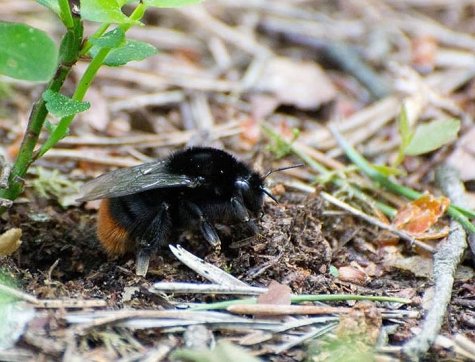Bumblebees have started nest life
Text Eneli Viik
Photo Tiit Jürisson
Translation: Liis
Red-tailed bumblebee
Red-tailed bumblebee Kivikimalane Bombus lapidarius
By now all the female bumblebees that mated last summer have left their winter quarters and found themselves a nest location. The first worker bumblebees can be seen on flowers too. How did it all happen?
After leaving the winter quarters which for late species took place only in May the main worry of the queen bumblebee is to quench her hunger with nectar and create a nest in a suitable location. The location of the summer nest depends on the species. Suitable up to 2 m deep burrows (for instance former mouse burrows), decayed tree stumps, cracks between stones, old leaves, areas between roots, tussocks of dried grass, bird nestboxes, windboxes and so on. Some prefer open areas (meadows, clearings), others hide in the shelter of trees. The nest is preferably built in areas open towards south and protected against winds. Having found a nest location the female bumblebee begins to construct it. The nest is lined with moss, the softer parts of plant leaves and hay, chaff and other materials that can be found nearby so that the nest will be camouflage-coloured. In case of an underground nest the tunnel is either horizontal or built into the slope with an upwards inclination because otherwise rainwater would run into the nest.
When the nest is ready the queen bumblebee begins to build the larva cell where she lays the first eggs from which within 3 weeks to a month and a half young bumblebees come out. Honey cells are built too, where food is stored. To start with the female bumblebee cares for feeding of the progeny and cleanliness in the nest. As the number of progeny increases the only remaining task of the female bumblebee becomes laying eggs; the workers build the honeycombs, care for the progeny, guard the nest and collect food. The workers are also all females as the queen but are usually much smaller. The male bumblebees appear only from mid-summer and live a relatively short time – the purpose of their life is only to fertilise the queens, they even collect food only for themselves.
Join the „Meie kimalased – Our bumblebees” group on Facebook: LINK
and share your pictures of the bumblebees in your garden with other enthusiasts!









